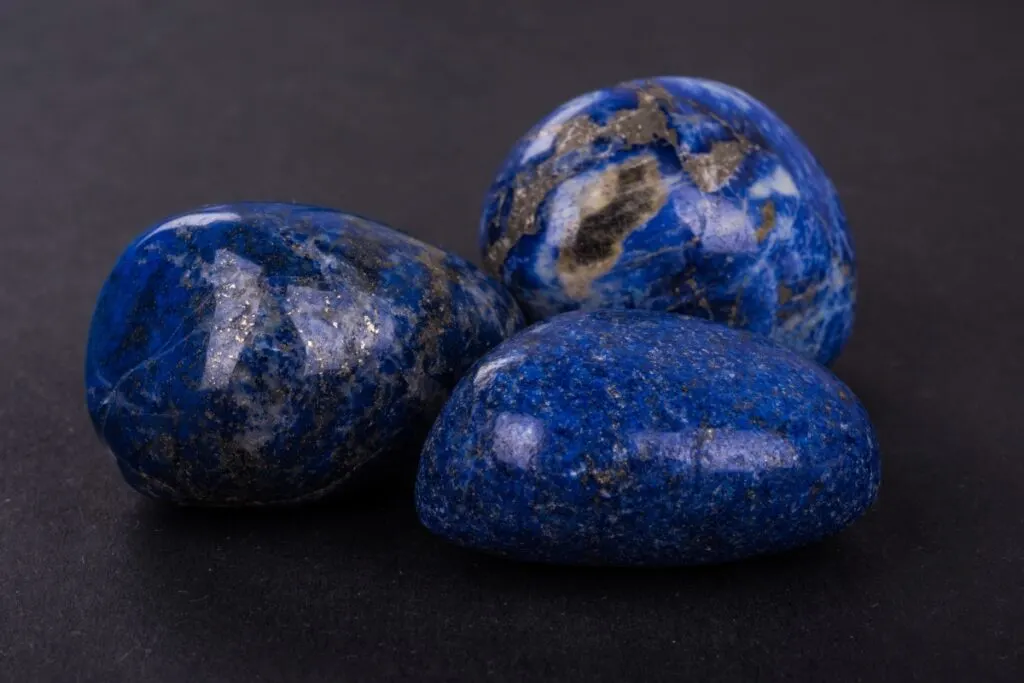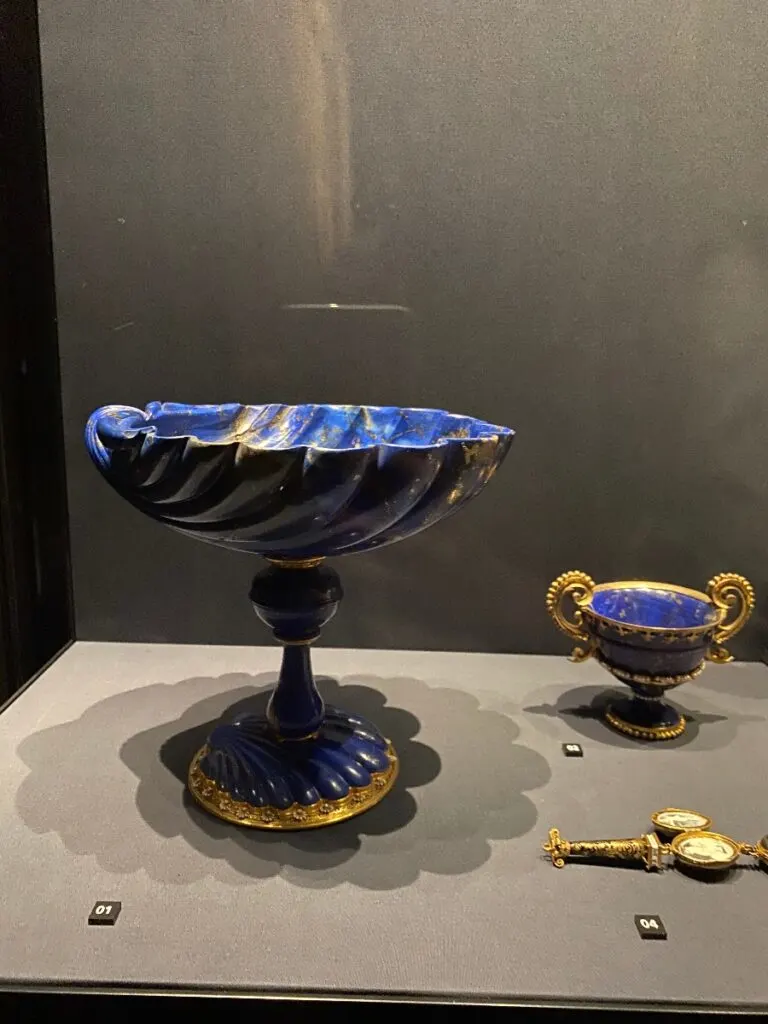As an Amazon Associate, I earn from qualifying purchases with no additional costs for you.
Lapis lazuli stays an idol among opaque blue gemstones for centuries. It is highly valuable because of its mysterious midnight-blue color and gold-yellow pyrite flecks. Additional value to lapis lazuli adds rare deposits in remote regions. Gem-quality lapis lazuli is undoubtedly the central stone in high-end jewelry pieces.
The finest uniform royal blue color is the main factor of lapis lazuli quality. The stone, free from a whitish calcite matrix and pyrite veins, makes a lapis lazuli even more valuable. A common lapis lazuli is around $2 per carat; however, top-quality pieces reach $100-150 per carat.
Lapis lazuli indigo color captivated people’s attention for millennia. It was not only used as ornamental or decorative stone but also as cosmetics, mosaics, and pigment. Ancient Egyptians ground lapis lazuli into powder for cosmetics use.
Of course, we cannot omit realistically carved scarabs from a piece of lapis in bracelets and the mask of Tutankhamun with lapis inlays. Renaissance painters coveted lapis as an ingredient for making “ultramarine” blue, an expensive pigment of unrivaled brightness and stability. All of this historical background and cultural heritage increase lapis lazuli value.

If you are interested in checking out the best books about rock and minerals identification you can find them by clicking here (Amazon link).
Is Lapis Lazuli Worth Anything
Because of the millennia-long history of lapis lazuli as a decorative, ornamental, and even industrial stone, it remains valuable.
Lapis lazuli is readily available in good quality for $2 per carat and around $10 per gram. In most cases, lapis lazuli is found in cabochons, beads, and tumble states. However, some exceptional quality lapis lazuli can be worth a lot, reaching hundreds of dollars per carat.
Lapis lazuli is actually a rock composed of different minerals. The one responsible for color is lazurite. It is a complex sodium calcium aluminosilicate mineral that contains sulfur. Haüyne, sodalite, and nosean are other blue minerals present in smaller amounts.
Finally, calcite and pyrite are the other minerals that create intriguing textures of lapis lazuli. Later you will know what minerals are favorable and increase the value of lapis lazuli and what minerals are less desirable.
How Much Is Lapis Lazuli Worth
Typical lapis lazuli prices are $2 per carat and $10 per gram; however, exquisite gem-quality material can be worth more than $100 per carat and $500 per gram.
Prices for common lapis lazuli in the form of cabochons (mostly treated) are indicted per piece and rarely reach $20 price tags.
Why is Lapis Lazuli So Expensive? Main Factors
Lapis lazuli is readily available on every mineral show in standard quality with prominent calcite matrix and pyrite flecks. Therefore, the price for this kind of stone is considered to be affordable.
But some pieces made from exceptional lapis lazuli, especially from ancient times, skyrocket on auctions. So let’s check out lapis lazuli value factors and understand these drastic price differences.
There are five main factors of lapis value: color, presence of matrix, craftsmanship, carat weight, and absence of enhancement. The most valuable lapis lazuli has a highly saturated medium to dark blue color. There should not be any visible calcite matrix. Lapis should be perfectly polished and not enhanced.
Color
Color is the most crucial factor of lapis lazuli value. Intense, uniform, medium-dark, slightly violetish blue is the most desirable color. Lapis lazuli is a rock composed of three minerals that provide different shades of blue and violet (lazurite, haüyne, sodalite, and nosean) with yellow pyrite inclusions and calcite matrix.
Lapis lazuli has three trade names that stand for different colors and, subsequently, different stone values.
- Afghan (Persian) lapis lazuli. These stones are intense, uniform, medium-dark, and slightly violetish blue. It absents calcite and has a small amount of pyrite.
- Russian or Siberian trade name of lapis lazuli stands for various tones and intensities of blue. It contains both pyrite and some calcite and is considered a middle value.
- Chilean lapis lazuli tradename describes greenish-blue material, tinged or spotted with apparent calcite matrix.
We pay attention to the fact that these are trade terms because historically, the quality of lapis lazuli rough material was so. However, it doesn’t mean that gem-quality material cannot come from Chili.
So, please, pay attention while buying lapis lazuli with these trade terms and always make sure whether it is just a trade description or the source of the material.
Presence of matrix (clarity)
The presence of a matrix is sometimes called clarity. Still, in the case of opaque lapis lazuli, it’s preferable to use matrix terms because clarity is more suitable for transparent or translucent gemstones.
The most valuable lapis lazuli has no visible streaks of white calcite matrix. On the other hand, pyrite inclusions are a matter of debate. Some people find them attractive, like stars in a blue midnight sky. Still, others prefer to avoid pyrite inclusions in high-end jewelry favoring unincluded stones.
Craftsmanship (cut)

Lapis lazuli is an opaque and relatively soft gemstone. These properties give unlimited opportunities for carving. Typically, lapis cutting styles for jewelry are cabochons, beads, inlays, and tablets.
However, lapis have been fashioned into practical objects throughout their history, including game boards, bowls, dagger handles, hair combs, and amulets.
High-quality lapis lazuli should be perfectly finished with a mirror polish, creating very sharp patches of reflected light. This type of finish is the most valuable concerning lapis lazuli craftsmanship.
Less valuable gemstones are not polished so well, and artisans usually spend little time making the surface flawless. Univen polishing makes lapis lazuli gemstones less valuable.
TIP: Minerals’ streak is one of the most important tests for mineral identification, especially while working with native metals and sulfide minerals. Find out the complete guide in the article below:
DIY Guide: Testing Mineral’s Streak (Explained by Expert)
Weight
The weight is quite a logical value factor. The bigger and heavier the piece, the better. However, there is one consideration factor regarding weight. A cutter has to decide whether to cut a smaller piece without the calcite matrix, increasing the price-per-carat.
Or to carve a big object with calcite and pyrite, lowering the clarity and color value factors. This is usually calculated based on market prices and possible customer preferences.
The presence of enhancement
As we discussed above, the main value factor of lapis lazuli is color. Therefore, resellers commonly use various treatments and dying to make lower-quality calcite-included lapis lazuli marketable. Even though treated lapis lazuli is far less valuable when disclosed.
If the treatment is not disclosed, lapis lazuli can seem more valuable. Lapis lazuli enhancement is ubiquitous, so we advise asking a seller whether a stone was treated/dyed/impregnated or not.
Sometimes lapis lazuli value can soar dramatically regardless of the saturation of the color, the presence of calcite inclusions, weight, or the quality of polishing.
This is an exceptional case of historical adornments like rings, bracelets, necklaces, or small statues of various cultures. In this case, the value of lapis lazuli is not evaluated according to the five factors above.
Lapis Lazuli Price per Gram, Kilo, Pound, and Carat

Generally, the lapis lazuli price is commonly expressed in per-gram units. Common-quality lapis lazuli costs $5-15 per gram. Gem-quality material prices can be expressed in per-carat units and reach up to $100-150 per carat, while common lapis lazuli recalculated into per-carat units will be only around $2.
The table below is designed to understand lapis lazuli prices for different units. The price per gram in bold is the most common for calcite- and pyrite-included lapis lazuli you can find on mineral shows. Per ounce, pound, and kilo prices are recalculated based on per-gram prices for common-quality lapis lazuli material.
| Unit | Lapis lazuli Price |
|---|---|
| per carat | $2 for common quality$100 –150 for gem-quality |
| per gram | $5 –15 for common quality $500 – 750 for gem-quality |
| per ounce | $140 – 420* |
| per pound | $2,240 – 6,720* |
| per kilo | $5,000 – 15,000* |
*recalculated prices for common quality lapis lazuli.
TIP: In case you want to tumble a specific material such as lapis lazuli, buying the specific tumbling rough is more comfortable than waiting until you collect a fair amount of rocks. Check out what rocks can be tumbled together in the article below:
What Rocks Can Be Tumbled Together: Complete List With Tips
Where to Buy Lapis Lazuli Stones
Lapis lazuli is quite an abundant gemstone on the market; however, it’s not a good idea to buy lapis lazuli via online platforms.
The material is cheap there, but on the other hand, it is almost always dyed. So instead, buy from specialized mineral resellers, ideally from that who can buy directly from the deposit.
It is a good idea to ask a reseller where did lapis lazuli sample come from. There are not so many deposits in the world, so you can easily spot a responsible seller and, as a result, good-quality natural material.
The traditional source of the finest lapis lazuli is the same today as it was thousands of years ago—the mountains of Afghanistan. Other significant sources are Chile and Lake Baikal in Siberia, Russia. Minor sources are located in Angola, Canada, Colorado (US), and Pakistan.
Conclusion
There are five main factors of lapis lazuli value.
- Color is the main factor that defines lapis lazuli’s value on the market. Blue to violetish blue, medium to dark in tone, and highly saturated color are the most valuable.
- Presence of matrix. The most valuable lapis lazuli is uniformly blue, free of visible pyrite flecks and calcite matrix.
- Craftsmanship. Lapis lazuli figures should be carefully carved and mirror-like polished.
- Weight. The greater weight of gem-quality evenly-colored lapis lazuli increases the value exponentially.
- The presence of enhancement. Any enhancement, treatment, impregnation, or dying decreases lapis lazuli value.
The price for lapis lazuli is commonly around $2 per carat, while gem-quality material reaches $100 – 150 per carat prices.
TIP: There are dozens of types of lapis lazuli fakes. They are dyed, reconstructed, and synthetic. Check out the main differences between real and fake lapis lazuli in the article below:
Real vs. Fake Lapis Lazuli: Focus on These 6 Differences
